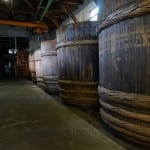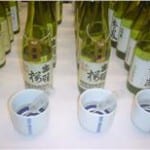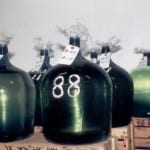~~~~~~~~~~~~~~~~~~~~~~~~~~~~~~~~~~~~~~~~~~~~~~~~~~~~~~~~~~~~~~~~~~~~~~~~~~~~~~~~~~~~~~~~
Know more. Appreciate more.
Announcing the launch of a new sake publication, Sake Industry News, a twice-monthly newsletter covering news from within the sake industry in Japan. Free until December 1! Subscibe before then and enjoy an 80% discount for ever. Learn more here.
~~~~~~~~~~~~~~~~~~~~~~~~~~~~~~~~~~~~~~~~~~~~~~~~~~~~~~~~~~~~~~~~~~~~~~~~~~~~~~~~~~~~~~~~
 The brewing season – the first one of the new Reiwa era in Japan – has just begun. Most places have a tank or two, maybe more, already fermenting away. The fall is also the season for lots of tasting events of all kinds of groups and of various scales.
The brewing season – the first one of the new Reiwa era in Japan – has just begun. Most places have a tank or two, maybe more, already fermenting away. The fall is also the season for lots of tasting events of all kinds of groups and of various scales.
Indeed, the fall is the traditional season for announcing to the world how well the sake of the previous brewing period has turned out. But there is another tasting season, in April or so, where breweries will show their just-brewed sake, called “shinshu,” with all involved knowing it is a bit too young to completely enjoy. Worded more diplomatically, it is understood that most sake will get even better with a few months’ maturation. Such shinshu is brimming with potential, and can tell us a lot about how things went over the past winter.
Most of these are large tastings comprised of many brewers and a lineup of sake from each. But one in particular that I look forward to and value highly each year is put on by just one small brewer, for a couple of hours, in the dim, less-than-extravagant office of his main Tokyo distributor. The fact that I am extremely fond of this kura’s sake is surely a big part of my excitement.
The sake is called Hitakami, from Miyagi, and in short, what Hirai-san the owner does is to line up 30 or so sake, mostly pasteurized but some nama (unpasteurized), all genshu (undiluted, so perhaps a couple of percent higher in alcohol), and all very young. But what is unique here is the chance for those of us in the industry to taste each tank brewed with all its sparkling individuality. No homogenizing blending, not at that stage anyway. No chance for the sake to mellow out. And nothing to equal the playing field amongst them.
 Bottles are lined up on a long, narrow table approachable on both sides, and flanked with spittoons strategically placed every meter or so. Each sake is labeled with the batch number of from whence it came. The handout received upon entering gives us the necessary information: “Batch #37, Junmai-shu, Hitomebore rice at 60%, Miyagi Yeast, Nama Genshu, Nihonshudo 5, Acidity, 1.5.” And so on down the line. Furthermore, we were given the date on which the sake was pressed, i.e. the day fermentation ended.
Bottles are lined up on a long, narrow table approachable on both sides, and flanked with spittoons strategically placed every meter or so. Each sake is labeled with the batch number of from whence it came. The handout received upon entering gives us the necessary information: “Batch #37, Junmai-shu, Hitomebore rice at 60%, Miyagi Yeast, Nama Genshu, Nihonshudo 5, Acidity, 1.5.” And so on down the line. Furthermore, we were given the date on which the sake was pressed, i.e. the day fermentation ended.
So each bottle at that tasting comes from a separate tank; none were blended. And this makes it extremely educational and interesting, as we can see how different tanks of sake brewed with the exact same ingredients and methods can be very, very different. And a tasting like this is the only time we can experience that. Why?
Because almost without exception, within a given brewery, each season all the sake of a particular grade that is destined to be sold as the same product will be blended together to ensure consistency. But they do not, for example, blend tank #33 and tank #54 since that combo would lead to something great, as they might do with some other alcoholic beverages. The intention is different.
 Are there exceptions to this? Of course there are. There are exceptions to everything in the sake world. For example, there are some brewers that deliberately do not blend their products so as to let the uniqueness of each tank do the talking – the sake called Mana 1751 is one such example. And one large and historically very significant company, Kenbishi, does in fact identify three or more tanks in each year’s batch that will morph into something very special when blended. But most of the time, for almost all brewers, blending is done to promote uniformity across all the tanks destined to be sold as one particular product.
Are there exceptions to this? Of course there are. There are exceptions to everything in the sake world. For example, there are some brewers that deliberately do not blend their products so as to let the uniqueness of each tank do the talking – the sake called Mana 1751 is one such example. And one large and historically very significant company, Kenbishi, does in fact identify three or more tanks in each year’s batch that will morph into something very special when blended. But most of the time, for almost all brewers, blending is done to promote uniformity across all the tanks destined to be sold as one particular product.
Consistency is an important expression of quality in the sake industry, both from bottle to bottle and from year to year. Ensuring that to the degree that it is possible is the objective of blending in the sake world.
~~~~~~~~~~~~~~~~~~~~~~~~~~~~~~~~~~~~~~~~~~~~~~~~~~~~~~~~~~~~~~~~~~~~~~~~~~~~~~~~~~~~~~~~
Know more. Appreciate more.
Announcing the launch of a new sake publication, Sake Industry News, a twice-monthly newsletter covering news from within the sake industry in Japan. Free until December 1! Subscibe before then and enjoy an 80% discount for ever. Learn more here.
~~~~~~~~~~~~~~~~~~~~~~~~~~~~~~~~~~~~~~~~~~~~~~~~~~~~~~~~~~~~~~~~~~~~~~~~~~~~~~~~~~~~~~~~





